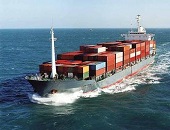Import and export price inflation continues with import prices and export prices up.
Analyst Opinion of the Import / Export Price Situation
The elephant in this month’s changes were fuel / oil commodities.
Import Oil prices were up 4.2 % month-over-month, and export agricultural prices were up 0.1 %.

There is only marginal correlation between economic activity, recessions and export / import prices. Prices can be rising or falling going into a recession or entering a period of expansion. Econintersect follows this data series to adjust economic activity for the effects of inflation where there are clear relationships.
Econintersect follows this series to adjust data for inflation.
Year-over-Year Change – Import Prices (blue line) and Export Prices (red line)

There are three cases of deflation outside of a recession – early 1990?s, late 1990?s, and mid 2000?s. Import price deflation is normally associated with strengthening of the dollar relative to other currencies.
According to the press release:
All Imports: Import prices rose 0.7 percent in September, the largest monthly rise since an increase of 0.7 percent in June 2016. The last time import prices advanced by more than 0.7 percent was a 1.2-percent increase in May 2016. Higher prices for both fuel and nonfuel imports contributed to the overall rise in import prices for September. Prices for U.S. imports also increased on a 12-month basis, advancing 2.7 percent.
All Exports: U.S. export prices rose 0.8 percent in September following a 0.7-percent increase in August. The September advance was the largest monthly rise since an increase of 0.8 percent in June 2016. The last time the index increased by more than 0.8 percent was a 1.1-percent advance in May 2016. Prices for exports rose 2.9 percent over the past year. The September advance was driven by rising prices for nonagricultural commodities; agricultural export prices decreased in September.













Leave A Comment